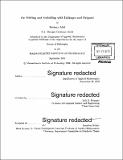| dc.contributor.advisor | Erik D. Demaine. | en_US |
| dc.contributor.author | Abel, Zachary Ryan | en_US |
| dc.contributor.other | Massachusetts Institute of Technology. Department of Mathematics. | en_US |
| dc.date.accessioned | 2017-03-20T19:39:26Z | |
| dc.date.available | 2017-03-20T19:39:26Z | |
| dc.date.copyright | 2016 | en_US |
| dc.date.issued | 2016 | en_US |
| dc.identifier.uri | http://hdl.handle.net/1721.1/107547 | |
| dc.description | Thesis: Ph. D., Massachusetts Institute of Technology, Department of Mathematics, 2016. | en_US |
| dc.description | Cataloged from PDF version of thesis. | en_US |
| dc.description | Includes bibliographical references (pages 121-127). | en_US |
| dc.description.abstract | We revisit foundational questions in the kinetic theory of linkages and origami, investigating their folding/unfolding behaviors and the computational complexity thereof. In Chapter 2, we exactly settle the complexity of realizability, rigidity, and global rigidy for graphs and linkages in the plane, even when the graphs are (1) promised to avoid crossings in all configurations, or (2) equilateral and required to be drawn without crossings ("matchstick graphs"): these problems are complete for the class IR defined by the Existential Theory of the Reals, or its complement. To accomplish this, we prove a strong form of Kempe's Universality Theorem for linkages that avoid crossings. Chapter 3 turns to "self-touching" linkage configurations, whose bars are allowed to rest against each other without passing through. We propose an elegant model for representing such configurations using infinitesimal perturbations, working over a field R(e) that includes formal infinitesimals. Using this model and the powerful Tarski-Seidenberg "transfer" principle for real closed fields, we prove a self-touching version of the celebrated Expansive Carpenter's Rule Theorem. We switch to folding polyhedra in Chapter 4: we show a simple technique to continuously flatten the surface of any convex polyhedron without distorting intrinsic surface distances or letting the surface pierce itself. This origami motion is quite general, and applies to convex polytopes of any dimension. To prove that no piercing occurs, we apply the same infinitesimal techniques from Chapter 3 to formulate a new formal model of self-touching origami that is simpler to work with than existing models. Finally, Chapter 5 proves polyhedra are hard to edge unfold: it is NP-hard to decide whether a polyhedron may be cut along edges and unfolded into a non-overlapping net. This edge unfolding problem is not known to be solvable in NP due to precision issues, but we show this is not the only obstacle: it is NP complete for orthogonal polyhedra with integer coordinates (all of whose unfolding also have integer coordinates) | en_US |
| dc.description.statementofresponsibility | by Zachary Abel. | en_US |
| dc.format.extent | 127 pages | en_US |
| dc.language.iso | eng | en_US |
| dc.publisher | Massachusetts Institute of Technology | en_US |
| dc.rights | MIT theses are protected by copyright. They may be viewed, downloaded, or printed from this source but further reproduction or distribution in any format is prohibited without written permission. | en_US |
| dc.rights.uri | http://dspace.mit.edu/handle/1721.1/7582 | en_US |
| dc.subject | Mathematics. | en_US |
| dc.title | On folding and unfolding with linkages and origami | en_US |
| dc.type | Thesis | en_US |
| dc.description.degree | Ph. D. | en_US |
| dc.contributor.department | Massachusetts Institute of Technology. Department of Mathematics | |
| dc.identifier.oclc | 974498685 | en_US |
